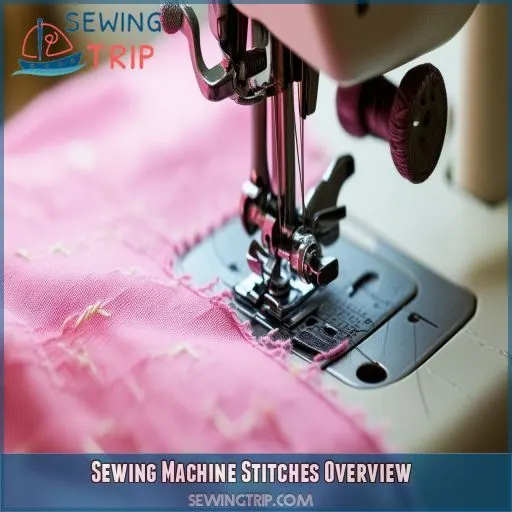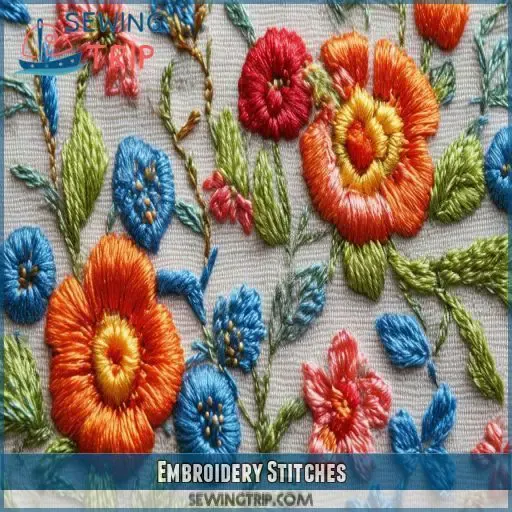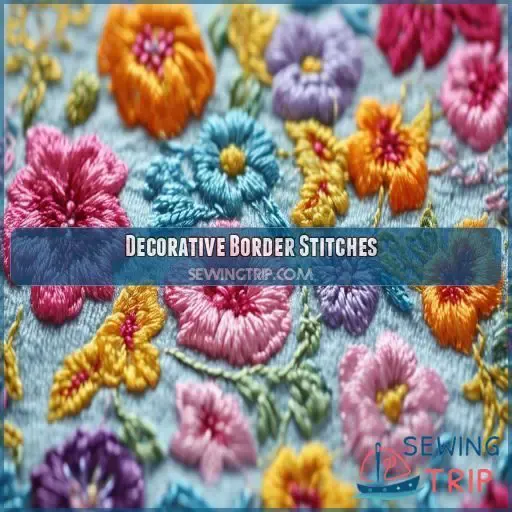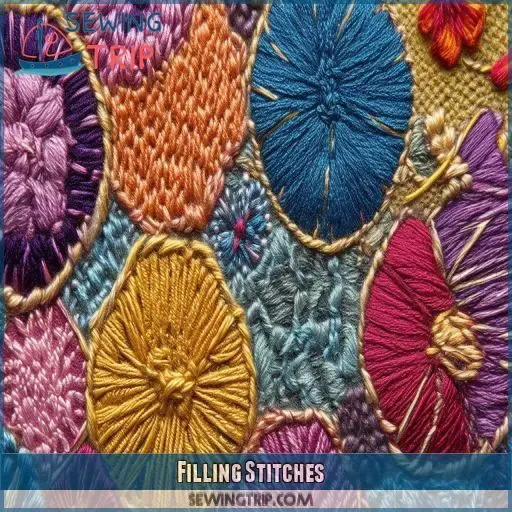This site is supported by our readers. We may earn a commission, at no cost to you, if you purchase through links.
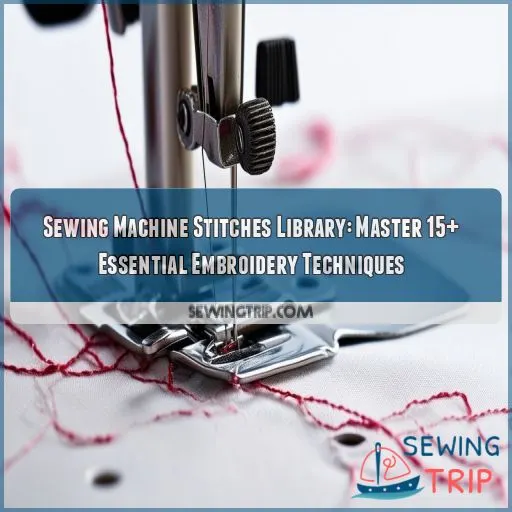 In your sewing machine stitches library, you’ll find an array of essential techniques to enhance your projects.
In your sewing machine stitches library, you’ll find an array of essential techniques to enhance your projects.
Basic stitches like the workhorse straight stitch and versatile zigzag stitch cater to everyday needs.
Specialized stitches, including stretch stitches for knits and blind hem stitches, provide precision and adaptability.
For embroidery, explore the chain stitch family for lines, fly stitch for delicate shapes, and feather stitch for elegant borders.
Decorative selections like the fern and Paris stitches add a unique touch, while filling stitches, such as the felt padded satin stitch, bring dimension.
Mastering these will elevate your craftsmanship.
Ready to expand your toolkit?
Table Of Contents
Key Takeaways
- Level up your sewing game with a masterclass on stitches! Straight stitch, zigzag stitch, you name it – we’ve got you covered.
- Spruce up your projects with specialized stitches like stretch stitches for stretchy fabrics or blind hem stitches for invisible finishes.
- Embellish like a pro with decorative stitches like the fern stitch and Paris stitch. Give your projects that extra touch of flair!
- Master filling stitches like the felt padded satin stitch to add dimension and texture to your creations.
Sewing Machine Stitches Overview
Your sewing machine’s a powerhouse of creativity, packed with stitches for every project. From the workhorse straight stitch to fancy decorative options, you’ve got a world of possibilities at your fingertips. Let’s explore the basics you’ll find on most machines, like the versatile zigzag and stretch stitches perfect for knits. Don’t forget about blind hem stitches for invisible finishes or the elastic stitch that’ll give your seams some wiggle room.
Want to jazz things up? Explore decorative stitches like the honeycomb or ladder stitch. They’re great for adding flair to your projects or even creating texture. If you’re battling fabric pucker, remember to check your tension and use the right needle. With practice, you’ll be combining stitches like a pro, creating unique textures and embellishments. Whether you’re a beginner or a seasoned pro, your stitch book’s about to get a lot more interesting!
Embroidery Stitches
You’ll find the Chain Stitch family, including Fly and Feather stitches, to be versatile embroidery techniques for creating lines and textures. For more structured patterns, try mastering Fishbone, Cretan, and Herringbone stitches, which offer unique visual appeal and can be used for filling shapes or creating borders.
Chain Stitch Family
Now, let’s explore the chain stitch family, a versatile group of embroidery techniques. When using your sewing machine for these stitches, remember:
- Choose the right embroidery thread
- Adjust tension to prevent fabric snagging
- Prepare your fabric properly
- Design your pattern carefully
Combine chain stitches with ladder stitches for unique effects. Experiment with stitch combinations to create stunning embroidery designs.
Fly + Feather Stitches
Fly and feather stitches are versatile embroidery techniques that’ll add flair to your projects. You’ll love how fly stitch variations create delicate leaf shapes, while feather stitch variations form elegant borders. Master these stitches to prevent fabric bunching and create intricate designs. Use them as bridging stitches or combine with buttonhole and scallop stitches for stunning effects.
Fishbone, Cretan, Herringbone
Now, let’s explore the realm of fishbone, Cretan, and herringbone stitches. These decorative powerhouses pack a punch in machine embroidery.
The fishbone pattern creates a neat, spine-like effect, while Cretan embroidery boasts a rich history. Herringbone stitch, with its V-shaped pattern, offers versatility in both hand and machine work.
Try these stitch variations to add depth and texture to your projects.
Decorative Border Stitches
You’ll find decorative border stitches essential for adding elegant finishes to your sewing projects. Let’s explore five key border stitches: Fern, Paris, Chevron, Double Chevron, and Buttonhole, each offering unique patterns to enhance your fabric edges.
Fern Stitch
You’ll love the fern stitch for creating delicate, nature-inspired borders. It’s versatile and easy to master. Adjust your thread tension and stitch settings to craft various fern patterns, perfect for dressmaking and embroidery projects.
Paris Stitch
The Paris stitch adds a touch of elegance to your embroidery projects. It’s a versatile border stitch that combines straight and zigzag stitches for a unique effect. You’ll love its adaptability and eye-catching appeal.
- Perfect for adding flair to hems and cuffs
- Easily customizable with different thread weights
- Pairs beautifully with shell tuck stitch for layered designs
- Great for creating texture on pillowcases and table runners
Chevron Stitch
Moving from Paris stitch, let’s explore the chevron stitch. This versatile border stitch adds a zig-zag flair to your projects. Here’s a quick guide to mastering it:
| Step | Action | Result |
|---|---|---|
| 1 | Stitch downward | / |
| 2 | Stitch upward | |
| 3 | Repeat | /// |
Double Chevron Stitch
Building on the chevron stitch, you’ll love the double chevron for creating eye-catching borders. It’s perfect for creative projects, adding unique accents to your fabric. Use a reverse pattern foot for precise stitching and stunning results.
Buttonhole Stitch
Moving from the double chevron, let’s explore the buttonhole stitch. This versatile technique isn’t just for securing buttons; it’s a decorative powerhouse. Master it, and you’ll elevate your embroidery game to new heights.
Filling Stitches
You’ll find two essential filling stitches in your sewing machine’s repertoire: the felt padded satin stitch and the raised stem stitch. These techniques allow you to create textured, dimensional designs by building up layers of thread on your fabric’s surface.
Felt Padded Satin Stitch
Moving from border stitches, let’s explore the realm of filling techniques with the felt padded satin stitch. This embroidery powerhouse adds dimension and drama to your projects.
You’ll start by selecting felt that complements your fabric weight and desired sheen. Layer it beneath your design, then cover it with dense satin stitches. The result? A raised, luxurious texture that’ll make your embroidery pop.
It’s perfect for decorative applications like monograms or floral designs.
Raised Stem Stitch
Moving from felt padding to raised stem stitch, you’ll find this technique adds depth and texture to your embroidery. Like a binder for your fabric, it creates a beautiful raised edge.
Start by working a row of stem stitches, then cover it with another layer, slightly offsetting each stitch. This method works wonders on curved designs and can handle fabric stretch.
For extra flair, combine it with honeycomb or elastic shell tuck stitches.
Knotted Line & Band Stitches
In Knotted Line & Band Stitches, you’ll work with techniques like Zigzag Coral Stitch, Palestrina Stitch, Knotted Pearl, Basque Stitch, and Couching. These stitches add texture and intricate detail, making your embroidery projects stand out.
Zigzag Coral Stitch
The Zigzag Coral Stitch, perfect for textured lines and bands, requires attention to thread tension and needle sharpness. It’s ideal for different fabric types, preventing crumpling and uneven pressure issues.
Palestrina Stitch
The Palestrina stitch guarantees durability with elegance. You create knots along a line that resemble twisted cord. Essential for:
- Securing seam allowances
- Combining with buttonhole twist
- Fixing poorly wound bobbin issues
Knotted Pearl
The knotted pearl stitch, rooted in traditional embroidery, offers amazing texture. Perfect for card stock, vinyl report covers, or using a Janome HD 220 or 230 DC. Great for embellishments and intricate projects.
Basque Stitch
The Basque stitch excels in decorative, textured lines and bands. It’s ideal for adding intricate, knotted details to your projects, offering variations in traditional embroidery and enhancing creative Basque stitch uses.
Couching
Couching techniques involve laying one thread on fabric and stitching over it with another. It’s perfect for bold couching embellishments, using varied couching materials for unique textures and stunning couching applications.
Frequently Asked Questions (FAQs)
What are all the stitches on my sewing machine?
Your sewing machine is a magical beast offering stitches like Straight, Zigzag, Triple Stretch, Blind Hem, and Honeycomb. Each one serves a specific purpose—from basic to decorative—to transform your fabric fantasies into reality!
Why is my sewing machine gathering stitches?
Your sewing machine might gather stitches due to high thread tension, uneven fabric pressure, or a blunt needle. Check thread tension, use a sharp needle, and make certain that fabric pressure is even to resolve this issue.
How to make a sewing machine stitch book?
Create a sewing machine stitch book by stitching examples of each stitch type on fabric swatches, labeling them, and organizing in a binder or scrapbook. This visual reference will enhance your understanding and mastery of different stitches.
What are the settings for sewing machine stitching?
Did you know that 60% of pucker issues come from incorrect thread tension? Confirm your machine settings are correct by adjusting stitch length, utilizing the right presser foot, and selecting a sharp needle.
What stitch type is best for stretchy fabrics?
For stretchy fabrics, use the Triple Stretch Stitch. It’s ideal because it stitches forward and backward, providing the necessary flexibility and strength to handle the fabric’s elasticity without breaking or distorting the seam.
How do I prevent thread from tangling on spool?
Use a thread net to keep the thread from tangling on the spool. It controls the thread’s flow, preventing snarls. Make certain the spool is correctly placed, and check thread tension frequently to maintain smooth sewing.
Can I use cotton thread on silk fabrics safely?
Yes, you can use cotton thread on silk fabrics. However, make certain it’s a fine cotton thread to avoid causing damage to the fabric. Adjust your sewing machine settings to handle the delicacy of silk.
What is the purpose of a walking foot attachment?
A walking foot attachment, often your trusty sewing sidekick, guarantees even fabric feeding during stitching. It’s essential for managing tricky textiles like quilts, stretchy materials, and layered fabrics, preventing bunching and misalignment.
Can I sew over thick seams or multiple layers?
Yes, you can sew over thick seams or multiple layers. Use a walking foot attachment, select a longer stitch length, and make certain you’re using a strong needle designed for heavy fabrics. Adjust machine tension if necessary.
Conclusion
Investigate whether mastering numerous stitches can transform your sewing projects. Enhancing your skills with the sewing machine stitches library offers precision and adaptability for various fabrics and designs. From basic to specialized embroidery stitches, to elegant borders and filling techniques, your toolkit will be complete.
You’ll gain the capability to add unique touches to every project, elevating your craftsmanship. Embrace these techniques, and see your creativity flourish with newfound expertise.
Ready to expand your toolkit? Start now.

